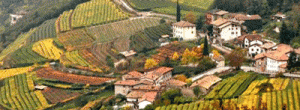Isera is a little village of Vallagarina,
but is composed by eight hamlets, some of these are Bordala, Marano, Patone and one of the most characteristic is certainly Lenzima, which rises on terracing of Mount Biaena. Already inhabited at the time of the Romans, it later became property of the Lords of Castelcorno, of the Castelbarco family and of the Lichtenstein family, who possessed it until 1759, when it passed to the prince bishop of Trent and later to Austria. It was an autonomous municipality until 1928 when it was annexed to the municipality of Isera. Despite the war, Lenzima managed to preserve the characteristic houses made of stone with the wooden balconies and, in some cases, stony elements in the window architraves and in the beautiful portals. Among the works preserved, the embossed processional cross of Saint Martin is very valuable; in the middle, it depicts the image of the saint as he cuts a piece of his cloak to give it to the beggar.

TERRITORY OF ISERA
Province: Trento
Hamlets: Bordala, Casette, Cornalé, Folaso, Lenzima, Marano, Patone, Reviano
Surrounding municipalities: Mori, Nogaredo, Ronzo-Chienis, Rovereto, Villa Lagarina
Population: 2.531 – Inhabitants name: iserotti
Hamlets: Bordala, Casette, Cornalé, Folaso, Lenzima, Marano, Patone, Reviano
Surrounding municipalities: Mori, Nogaredo, Ronzo-Chienis, Rovereto, Villa Lagarina
Population: 2.531 – Inhabitants name: iserotti
The Isera is located on the western side of the Adige in front of Rovereto, its territory extends over most of the mountain Biaena and to the east it is bordered along its entire length by the river Adige, its hamlets of Bordala, Lenzima, Marano, Patone, are distributed along the river and on the slopes of the mountain.
HISTORY OF ISERA
Significant is the presence of humans since prehistoric times, were found traces of Palaeolithic hunters; significant discoveries date back to the Neolithic age, it is perched villages and traces of settlements, the late-Neolithic are also some discoveries made in the area of Castel Horn and Castel Pradaglia. One another over time various owners as the Lords of Castelcorno, the Castelbarco Lichtenstein and up to half of the eighteenth century. The territory of Austria Isera remained until the First World War.
TYPICAL LOCAL PRODUCTS
